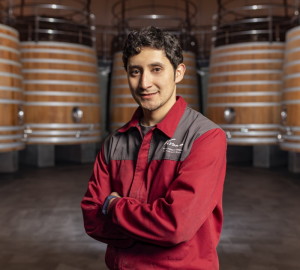What is a young wine? Often, when we approach the world of wine for the first time, we tend to associate the different levels of crianza and ageing of a wine with its quality. Thus, we might assume that a gran reserva wine is going to be a wine of superior quality than a reserva, which in turn is going to be better than a crianza, which in turn is going to be a wine of higher quality than a young wine. Nothing could be further from the truth. The ageing and cellaring that we give to a wine is not a direct synonym of quality, but refers to a process through which we are going to provide the wine with a series of different characteristics.. And different only means different, neither better nor worse. Thus, we can enjoy magnificent young wines, crianza, reserva or gran reserva. All of them are good, but different from each other.
To shed some light on this subject, Today we will see what a young wine is and what its main characteristics are. We will also look at the main differences that can be found between young wines and wines for ageing. And finally, we will get to know the young wines Vivanco: the wine Vivanco Viura-Tempranillo Blanco-Maturana Blanca and the wine Vivanco Tempranillo Garnacha Tinta y Blanca.
What is a young wine?
When we talk about a young wine, we are referring to wines that have been bottled just after alcoholic fermentation has taken place. during the winemaking process. This means that they are wines that do not go through the wood of the barrels or that, if they do, they do so for too short a period of time to be considered as wines for ageing. The latter will depend on the time limits established by the Regulatory Council of each Designation of Origin.
For example, in the case of the Rioja Qualified Designation of Origin, in order for a red wine to be considered as crianza it must have spent at least 12 months in Bordeaux oak barrels.
Thus, a young wine is usually a wine that has not been aged in oak barrels, but is bottled after the alcoholic fermentation of the grapes has been completed. In this way, the aim is to preserve and enhance the characteristics that come directly from the grapes. primary and secondary aromatic characteristics of wineThe characteristics that come directly from the vines used to make the wine or from the physico-chemical processes of fermentation.
In the case of young red wines, an alternative fermentation process to the traditional one is sometimes used: carbonic fermentation. To do this, the bunches of grapes are placed in tanks that are subsequently filled with carbon dioxide. This method allows fermentation to take place inside the grapes themselves. The result is wines that vividly reflect the characteristics of the grape varieties used to make them. The downside of this type of fermentation is that the wines produced have a shorter shelf life and lose their properties earlier than wines subjected to the traditional fermentation process.
These young wines will be marketed during the same year of the harvest or during the following year. This is why they are also known as "vintage wines" or "wines of the year". This is the opposite of what happens with wines for ageing, in the case of young wines, the passage of time does not help their organoleptic characteristics to develop positively. In this sense and in general, we should not allow more than 2 or 3 years to pass from the moment of the harvest to consume a young wine.
Characteristics of young wines and differences with mature wines crianza
As we have seen, in the process of making young wines, we dispense with the wine's stay in oak barrels, or we minimise the length of this stay by keeping it below the minimums contemplated by the Denominations of Origin. This is done to enhance the primary and secondary aromas of the wine, those that come from the characteristics of the grapes themselves or from the fermentation processes.
- Among the primary aromas we can find floral aromasrose, jasmine, violets, etc..; aromas fruit aromasstrawberry, raspberry, blackcurrant, cherry, pear, apricot, etc.; vegetal aromasgrass, hay, etc.; or mineral aromas: wet slate, peat, peat moss, graphite, etc.
- As for those secondary aromas from alcoholic, malolactic or carbonic fermentations, we would speak of fermentation aromas: bread, sponge cake, etc..; lactic aromasyeast, milk, yoghurt, etc.; or amyl aromas: varnishes, bananas, etc.
In the case of wines with crianzawines, the passage of these wines through oak barrels for their evolution and ageing will cause them to develop the most subtle and ephemeral nuances, reminiscent of the aromas of wood, oak tertiary aromasIn the case of the oak barrels, more subtle and ephemeral nuances, which will remind us of the aroma of wood, coffee, leather, nuts or pepper, among others.
Apart from the aromatic characteristicsother characteristics that we can observe in young wines, although always speaking in a very general way and bearing in mind that these characteristics can vary enormously from one wine to another, would be a good level of acidity, the vivid and bright colours, a moderate body and a alcohol concentration of around 12 degrees.
Wines with crianza, on the other hand, will generally show more evolved and complex organoleptic characteristics. They will normally present more body and structuremore oiliness, more muted colours and less opaque layers, lower acidity and higher alcohol concentration.
Young people Vivanco
The type of wine: red, white or rosé, is not incompatible with the maturation time. Thus, we can find young red wines, rosés with some time in oak barrels, reserve whites, etc. In the case of Vivanco, our two young wines are the Vivanco Viura-Tempranillo Blanco-Maturana Blanca and the Vivanco Tempranillo Garnacha Tinta Y Blanca. A white wine and a rosé.
- The wine Vivanco Viura-Tempranillo Blanco-Maturana Blanca is the first wine in the world made from this blend. coupageThe wine is made from grape varieties from the family's own vineyards Vivanco, harvested by hand and kept cold for 36 hours before being processed. The different varieties undergo a cold maceration and then the tear must is extracted, which is fermented in small steel tanks at 12-15 degrees. Afterwards, the musts are macerated with their lees for 4 months to enhance and harmonise the varietal aromas and increase the unctuousness of the wine. The result is a bright yellow white wine with a complex and intense aroma with notes of citrus fruits, green apple and white peach. Fresh and tasty, it is a perfect wine for tapas or to enjoy with any aperitif.
- This wine is the reinterpretation Vivanco Tempranillo Garnacha Tinta Y Blanca is Vivanco 's reinterpretation of the traditional Rioja claret. A rosé somewhat paler and more refreshing that reflects all the characteristics of the grape varieties used through the maturation of the grape juice for 3 months on the lees. The resulting wine shows a bright pink colour with violet reflections, with aromatic notes of red liquorice, strawberries, raspberries, roses and violets. A fresh and unctuous wine, with a well-balanced acidity and a sweet and fruity finish. Perfect to accompany vegetables, salads, white meats, pasta... or to serve with an aperitif and all kinds of tapas.

Now we know a little better what is a young wineThe main characteristics that we can identify in them and the best time to consume them in order to enjoy their optimum moment of ripeness.


















